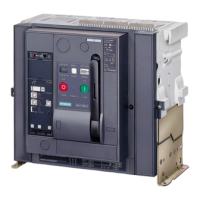Electronic Trip Unit
WL Circuit Breaker
1/40
WL Selection and Application Guide • 2005
Electronic Trip Unit
During development of our
electronic trip units, we have
consistently striven to ensure
modularity. The following are
just some of the modules that
are simple to retrofit at any
time:
• Ground fault protection
• Communication
• Metering function
• Displays
• Rating plugs
This enables fast local
adaptation to new system
conditions. At the same time,
the ETUs are provided with
new, innovative functions, and
all trip units are completely
interchangeable independent of
breaker ratings.
Rating Plug
The Rating Plug is a replaceable
module that enables users to
reduce the rated device current
for optimum adaptation to the
system; e.g. during startup of a
plant section. The Rating Plug
should be selected so that
it corresponds to the rated
current of the system.
Switch-selectable I
2
t or I
4
t
Characteristic Curve Improved
Overload Protection
The best possible protection
is assured when all protective
devices in the system are
optimally coordinated. To
achieve optimum selectivity
and coordination, the long-time
characteristic can be switched
between l
2
t and l
4
t.
Switchable Parameter Sets
To allow the protection to adapt
to changes in system needs
such as switching between
utility and generator feeds,
WL Circuit Breakers support
ETUs with two independent
parameter sets. Switching
between the parameter sets
occurs in less than 100 ms and
can be done remotely or via a
contact input to an optional
CubicleBUS module.
Dynamic Arc-Flash Sentry (DAS)
employs the unique dual
protective setting capability
of the 755 and 776 trip units,
coupled with the ability to
easily toggle to a lower arc
flash parameter set. A normal
operation parameter set can
be optimized for selective trip
coordination while the second
set is optimized for lower arc
flash energy levels.
Sample configuration of an ETU745
Manual Trip Indicator
with optional remote
RESET
LCD display with
adjustable-angle
viewing
Micro switches for
switch selectable
characteristic curve
adjustments.
Rating Plug
Ground Fault
Protection
Module
(field installable)
Extended Instantaneous
Protection
The electronic trip units
designed for use with the WL
low voltage power circuit
breaker provide a feature we
call “Extended Instantaneous
Protection” (Patent Pending).
It allows the WL breaker, as a
family, across the entire range
of ampacities to be applied at
the withstand rating of the
breaker with minus 0%
tolerance; that means no
instantaneous override
whatsoever. EIP further enables
the circuit breaker to be applied
up to the full interrupting rating
of the breaker on systems
where the available fault
current exceeds the withstand
rating, even with LS-only trip
units. Why is this feature
important? The answer is
reliable power.
The coordination of the main
breaker and the first level of
feeder breakers is especially
important because of the wide
spread outage that will occur if
one of these breakers trips
unnecessarily. Conventional
practice is to specify electronic
trip beakers with “LS” type trip
units in critical power systems.
These ‘Long-Time’ and ‘Short-
Time’ only trip units forgo the
fast tripping times given by an
‘Instantaneous’ function. The
justification for this delay is
the benefit of allowing a
downstream breaker to open
first to clear a high magnitude
fault. The main or feeder stays
closed to keep the remainder
of the loads operating.
However, a circuit breaker with
an LS-only trip unit may never
be applied on a system capable
of delivering fault current
higher than the breaker's
withstand rating, commonly
85kA or less. Where the
available fault current is above
this level, a breaker with an
additional function must be
used - an instantaneous
override. This instantaneous
override function trips the
breaker instantly when the
fault current reaches a pre-
determined level below the
withstand rating, usually
around 20% lower. The benefit
of this override is to allow
application of the breaker up
to the interrupting rating,
which may be as high as
150kA. The disadvantage is that
it compromises the
coordination benefit because
the main will probably trip at
the same time as a downstream
branch breaker in that 20%
lower override window.
This is where the Extended
Instantaneous Protection
feature of the WL can offer the
next level of coordination and
protection functionality. Unlike
an instantaneous override,
Extended Instantaneous
Protection (EIP) allows the full
withstand rating - in fact up
to the tolerance of plus 20%
higher. Of course, EIP still
provides the ability of the
breaker to be applied at the
interrupting level, as high as
150kA in a Frame Size III, non-
fused breaker. This unique
combination enables the
system designer to achieve the
highest possible level of
coordination in the industry
and also allows application of
the WL on modern power
systems with extremely high
levels of available fault current.
A further benefit offered by EIP,
over a standard LS trip unit
equipped breaker, is that it
provides an extra measure of
protection in the event that the
available fault current increases
at some time during the life of
the system beyond the
withstand level. This would
typically be due to a utility
transformer change but
could also be due to the
addition of generators or large
motors that contribute fault
current. EIP provides the
breaker the ability to react in
an instantaneous fashion to
a high level fault instead of
having to rely on the slower
reaction time of the short-time
function.
WL_SA_intro-sec1.qxd 2/7/05 1:21 PM Page 42

